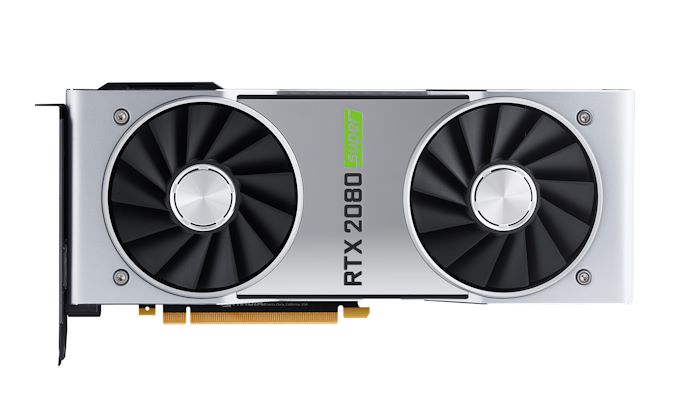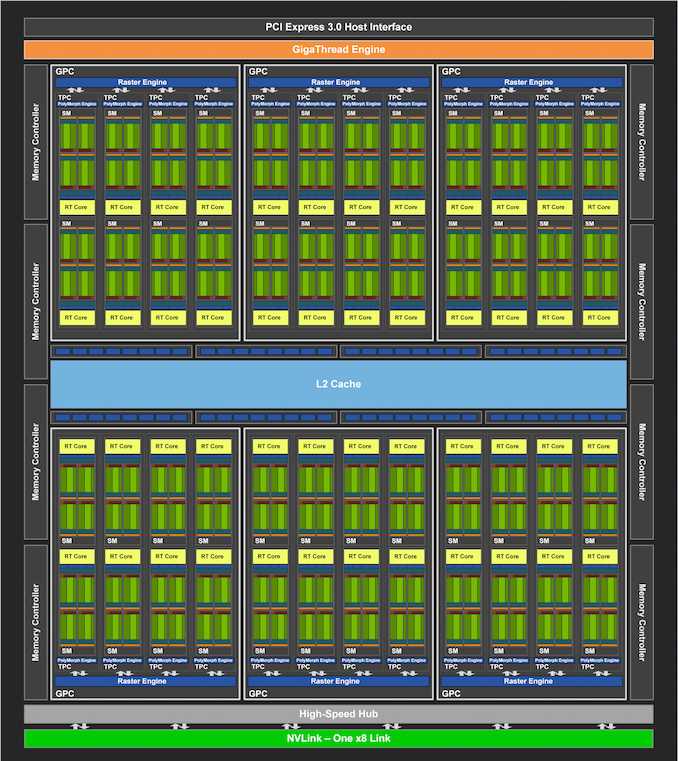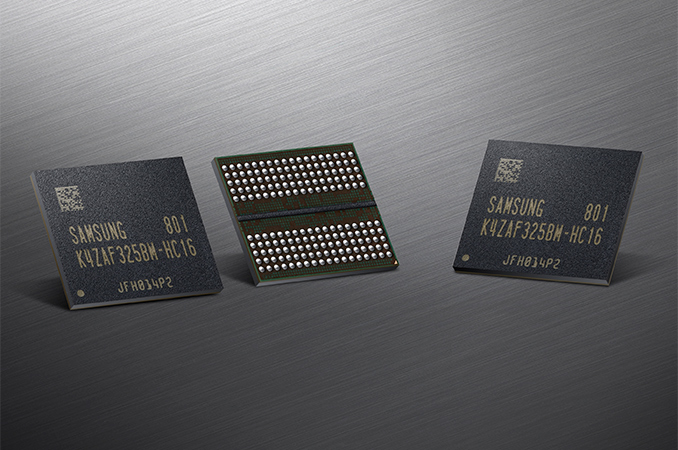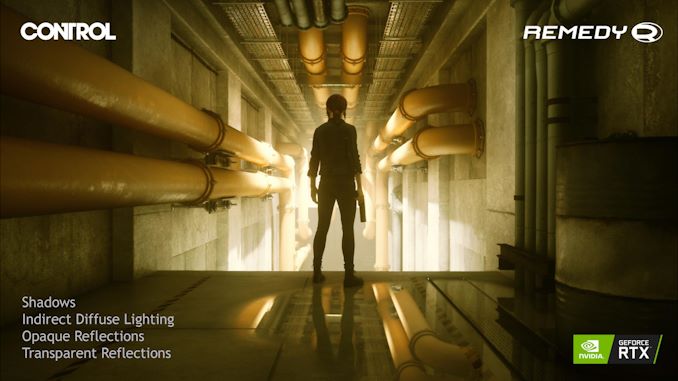The NVIDIA GeForce RTX 2080 Super Review: Memories of the Future
by Ryan Smith on July 23, 2019 9:00 AM EST- Posted in
- GPUs
- GeForce
- NVIDIA
- Turing
- GeForce RTX

The last two months have been a period of tit-for-tat in the PC video card industry. Both AMD and NVIDIA have been going back and forth, making announcements and launching products as part of a broader restructuring of the mid-range and high-end video card markets in response to the launch of AMD’s Radeon RX 5700 series of video cards. Performance is going up while last-minute maneuvering has brought prices slightly down, all the while the two major players in the GPU space look to solidify their product lineups and secure their competitive edge against their competition.
For all practical purposes, NVIDIA’s GeForce RTX 20 Super series has been the company’s response to AMD’s new video cards. A combination of a mid-generation kicker and a product stack realignment to go head-to-head with AMD, the Super cards have given NVIDIA’s product lineup a modest performance boost at almost every level. After launching the first two cards in this sub-series early this month with the GeForce RTX 2070 Super and GeForce RTX 2060 Super, NVIDIA is back again to launch the last (?) of the Super cards: the previously announced GeForce RTX 2080 Super.
Since gamers have had a couple of weeks to chew on this one – specs and all – there aren’t any last-minute surprises here. The GeForce RTX 2080 Super is a minor performance bump for what was the GeForce RTX 2080, offering a couple more SMs and higher clockspeeds to push performance a bit higher, while holding the price at $699. Truthfully, it’s not a card that’s going to light the world on fire or set any new performance records; but it’s a card that’s going to deliver better performance than the RTX 2080 did at this point yesterday, and it’s going to restore some breathing room between NVIDIA’s 2070 and 2080 cards, as the new RTX 2070 Super has all but made the vanilla RTX 2080 redundant.
| NVIDIA GeForce RTX 20 Series Lineup | |||
| Card | Price | ||
| GeForce RTX 2080 Ti | MSRP: $999 (Street Price: $1149) |
||
| GeForce RTX 2080 Super | MSRP: $699 | ||
| GeForce RTX 2080 | EOL ($699) | ||
| GeForce RTX 2070 Super | MSRP: $499 | ||
| GeForce RTX 2070 | EOL ($499) | ||
| GeForce RTX 2060 Super | MSRP: $399 | ||
| GeForce RTX 2060 | MSRP: $349 | ||
Unsurprisingly then, the vanilla RTX 2080 is on its way out. As part of the Super card launch, the RTX 2080 and RTX 2070 are being discontinued. So the RTX 2080 Super is for all practical purposes the new RTX 2080. Which is to say the fastest of NVIDIA’s semi-affordable high-end video cards, heir to the 80-card family name, and a part targeted at a mix of 1440p and 4K gaming.
And, as we’ll see, it is both the least and most interesting of the Super card launches.
| NVIDIA GeForce Specification Comparison | ||||||
| RTX 2080 Super | RTX 2080 Ti | RTX 2080 | RTX 2070 Super | |||
| CUDA Cores | 3072 | 4352 | 2944 | 2560 | ||
| ROPs | 64 | 88 | 64 | 64 | ||
| Core Clock | 1650MHz | 1350MHz | 1515MHz | 1605MHz | ||
| Boost Clock | 1815MHz | 1545MHz | 1710MHz | 1770MHz | ||
| Memory Clock | 15.5Gbps GDDR6 | 14Gbps GDDR6 | 14Gbps GDDR6 | 14Gbps GDDR6 | ||
| Memory Bus Width | 256-bit | 352-bit | 256-bit | 256-bit | ||
| VRAM | 8GB | 11GB | 8GB | 8GB | ||
| Single Precision Perf. | 11.2 TFLOPS | 13.4 TFLOPs | 10.1 TFLOPS | 9.1 TFLOPS | ||
| TDP | 250W | 250W | 215W | 215W | ||
| GPU | TU104 | TU102 | TU104 | TU104 | ||
| Transistor Count | 13.6B | 18.6B | 13.6B | 13.6B | ||
| Architecture | Turing | Turing | Turing | Turing | ||
| Manufacturing Process | TSMC 12nm "FFN" | TSMC 12nm "FFN" | TSMC 12nm "FFN" | TSMC 12nm "FFN" | ||
| Launch Date | 07/23/2019 | 09/27/2018 | 09/20/2018 | 07/09/2019 | ||
| Launch Price | $699 | $999 | $699 | $499 | ||
Starting from the top, let’s take a look at the specs. When NVIDIA launched their GeForce RTX 20 series cards last year, the 2080 and 2080 Ti were somewhat conservatively configured; both cards shipped with a few disabled SMs (among other things), which is to say that they utilized less-than-fully-enabled GPUs. This helps with binning, of course, but it also gave NVIDIA some breathing room to bump up their performance should they ever need to. Now, with the RTX 2080 Super, they are doing just that.
For the first time in a GeForce RTX 20 series card, we’re finally getting a fully-enabled TU104 GPU. NVIDIA is enabling the final 2 SMs, adding a further 128 CUDA cores to the pool, for a total of 3072 CUDA cores. With the final two SMs comes their respective PolyMorph engines and RT cores, so the RTX 2080 Super is coming to bat with everything the GPU can offer on the shading, texturing, geometry, and ray tracing fronts. The notable exception here will be on the render backend side of things; RTX 2080 already shipped with all 64 ROPs enabled – as well as the associated L2 cache – so there are no hardware improvements here.
Instead, pushing the card even farther are higher clockspeeds, coupled with a very generous 250W TDP. As RTX 2080 overclockers already know, TU104 can easily sustain clockspeeds higher than NVIDIA’s RTX 2080 reference clocks, however the cost is increased power consumption and all the drawbacks that entails. So for the RTX 2080 Super, the base and boost clocks have been bumped up by 9% and 6% respectively, and the card should now generally be able to sustain 1815MHz (or better) on most games – and this might be a bit conservative. Meanwhile, unlike enabling more SMs, this benefits every facet of the video card, so front-end and back-end performance is all getting faster.
The penalty for this is that the 215W TDP RTX 2080 is being replaced with the 250W TDP RTX 2080 Super. This happens to be the same TDP as the even faster GeForce RTX 2080 Ti, so it’s easy to see where this is going: NVIDIA is bumping up their overall performance, at the cost of some power efficiency. As we’ll see in our benchmarks, the situation is a little more complex than that, but not immensely so. Perhaps the wildest factor here is that unlike the RTX 2080 Ti, the RTX 2080 has trouble actually filling out its 250W TDP; NVIDIA boosted the TDP to ensure the card had sufficient power headroom for higher clocks, and they definitely succeeded. As a result, the card gets to run at full throttle a lot more than the original 2080, or for that matter the 2080 Ti or the 2070 Super.
Faster GDDR6 Memory Comes to Video Cards
But perhaps the most interesting change with the RTX 2080 Super isn’t even the GPU itself, but rather what NVIDIA is doing to feed the beast on the memory front. Since the first GDDR6-equipped video cards launched a year ago, every card has shipped with 14Gbps (or lower) memory. 14Gbps was the fastest speed grade available at launch from the major memory vendors, however it wasn’t the fastest speed grade on the roadmap. 16Gbps memory has been on the drawing board as well, and now with the launch of NVIDIA’s new card, we’re getting our first card with that memory.
For the launch of their new cards, NVIDIA has tapped Samsung’s new 16Gbps, 8Gbit chips for the new cards. With a 256-bit memory bus for the card itself, this keeps the RTX 2080 Super at the same 8GB of VRAM as the original RTX 2080, but it gives the card more bandwidth to play with. However in a rare move for NVIDIA, they’re actually being a bit conservative here on memory clocks – the RTX 2080 Super is only running at 15.5Gbps instead of the 16Gbps the memory is capable of.
According to NVIDIA, the reason for this ultimately comes from their decision to make the Super cards as straightforward a manufacturing upgrade as possible, spec’ing the cards such that board partners (including themselves) can use the same boards and coolers from their vanilla RTX 2080 cards. As a result, the RTX 2080 Super is built on a PCB originally designed and qualified for 14Gbps GDDR6. True 16Gbps memory clocks would seemingly require a new PCB, which for a 3% memory clockspeed bump (and less on performance) is not something board makers are going to want to spend the money on.
To be sure, I’ve clocked our card to 16Gbps with ease and without any problems; but then our standards for stability are not as high as NVIDIA’s (never mind mass production concerns). So for curious overclockers, there is a bit more memory headroom to play with here, with the usual warnings about overclocking. Meanwhile for everyone else, the net result is that the RTX 2080 Super has 11% more memory bandwidth than the RTX 2080 it replaces (and the RTX 2070 Super).
As a result of this and the higher TDP, the RTX 2080 Super tends to be more heavily GPU-bound than most NVIDIA cards. The higher memory speeds more than make up for the fully enabled GPU and its higher clockspeeds, so while no GPU has memory bandwidth to spare, RTX 2080 Super is rather well fed. It also means that overclocking is going to be a bit more one-dimensional, with GPU clockspeeds being the biggest factor by a significant degree.
Product Positioning, Availability & the Competition
As with the other RTX 20 series Super cards, NVIDIA and its partners are going to hit the ground running here with everything from reference cards to fully custom cards. These are the same TU104 GPUs using memory validated to run on the same PCBs, so board partners can quickly tap their existing 2080 designs to bring new cards to market. Similarly, card volume shouldn’t be a big issue – though as we’ve seen with the now sold-out RTX 2070 Super, demand is front-loaded, so there’s still the potential for sell-outs.
Also like the other Super cards, NVIDIA is once again be releasing their own reference card. Unlike last year’s factory overclocked Founders Edition RTX 2080, NVIDIA will not be overclocking their RTX 2080 Super or charging a premium for it. Their reference card is still going to be sold under the Founders Edition branding, however it should perform identically to any other reference-clocked cards. Meanwhile, as is usually the case, the cards will be sold directly by NVIDIA.
NVIDIA is also extending their latest video game bundle to the new card. The RTX 2080 Super gets a two-game bundle that consists of Wolfenstein: Youngblood and Remedy’s upcoming Control. NVIDIA for its part has been avoiding game bundles at launch for its high-end cards for most of the past few years, so it’s noteworthy to see them included here. As part of their overall product stack realignment, NVIDIA is looking to increase the value of their cards without actually cutting prices, so this is another way to achieve that.
Meanwhile the competition for the RTX 2080 Super is a mixed group. With the vanilla RTX 2080 on its way out (along with the RTX 2070), on the NVIDIA side of matters the competition is the RTX 2080 Ti above, and the RTX 2070 Super below. The RTX 2080 Ti remains NVIDIA’s fastest GeForce card by a good margin, however card prices have been wacky for months and it hasn’t stopped. Even the cheapest (new) card will set you behind by $1150, a $450 premium over the RTX 2080, a gap so large that if you have to ask which card to pick, you probably can’t spare the money. Meanwhile the RTX 2070 Super is definitely the spoiler to NVIDIA’s stack; the card offers performance just a bit under the original RTX 2080 for $200 less (perhaps it’s not too surprising then that the card is currently sold out).
As for AMD’s cards, technically AMD’s closest competition is the Radeon VII, which came to life as a surprise back in January of this year. The card offers generally RTX 2080-like performance for $699. However even before today’s RTX 2080 Super launch it’s arguably been stillborn in the consumer & PC gaming spaces – it just didn’t do anything better than the RTX 2080 – and the RTX 2080 Super puts the last nail in that coffin. Far more interesting at a fraction of the price is the new Navi-based Radeon RX 5700 XT. It’s not an RTX 2080 Super competitor, but it’s potentially an even larger spoiler than the RTX 2070 Super, offering a whole lot of performance for $300 less. Overall the RTX 2080 Super may be semi-affordable compared to the RTX 2080 Ti, however it’s still decidedly a high-end NVIDIA card, so perf-per-dollar isn’t a strong selling point here.
| July 2019 GPU Pricing Comparison | |||||
| AMD | Price | NVIDIA | |||
| $1149 | GeForce RTX 2080 Ti | ||||
| Radeon VII | $699 | GeForce RTX 2080 Super | |||
| $499 | GeForce RTX 2070 Super | ||||
| Radeon RX 5700 XT | $399 | GeForce RTX 2060 Super | |||
| Radeon RX 5700 | $349 | GeForce RTX 2060 | |||













111 Comments
View All Comments
designgears - Tuesday, July 23, 2019 - link
Oooh right, forgot about that.Dragonstongue - Tuesday, July 23, 2019 - link
minor speed bump I consider anything 50Mhz range, not in the hundreds quicker IMHOI personally feel like Nv still up to their dirty old deceitful tricks/ways and making excuses as to the why. if they were able to release as "super" this quickly for the price reduction "sort of speak" that says they very much should have done this right off the bat instead of making a song and dance about it, effectively screwing early adopters of their products (YET AGAIN) just to slap a faster version (slight less+cost so basically the same price for even faster)
A price reduction after release, I understand, a price reduction and a faster Overclocked version 3-7mth down the line to "freshen up" absolutely, but, a bait and switch (like the "new" nintendo switch same context, shafting of early adopters, which happens all the time, but in tech world Nv/Apple/Intel were/are notorious terrible at this.
All that being said, I wonder how fast a 2080 any version esp the Ti be WITHOUT the ray trace crap being shoved into it, i.e do "standard DX features/subfeatures that do not require proprietary hard/software"
I would imagine the transistor budget they used for the RT cores were likely more as a direct result of them cleaning and chopping as they had since the GTX 500 generation (basically) to get the speed up and power use down.
By them gutting and re-arrange the transistors etc they were left with a bunch they could NOT use for much of anything else (or power would go up and speed would go down type thing) so they settled on things like Gsync, all the various Nvidia "game" features (shadow play, Raytrace etc etc)
anyways. would be cool if they did in fact offer 2 versions for each of these, 1 with and 1 without ray tracing, likely the non RT would be quite a bit faster and similar reduction in the power from not having to power extra "junk in the trunk"
in this, AMD would do very well to not worry about all that extra crud just because someone else is, focus on speed and power everything else is "old news"
features such as Raytracing the way they do it is a self defeating sales pitch, basically "here is a cup of water, in 1 second you lose X of that water and owe me Z more for the remaining amount, better hurry up as the next cup of water is changing it's internal design a wee bit to deliver the water in fancier ways so it will appear to be better water but in fact is less of the water you actually want as they had to make room for and price in the fancy cup design which has only ONE purpose compared to the cup itself which could just be made bigger with a smaller exit to ensure water is there forever"
Maxiking - Tuesday, July 23, 2019 - link
I will tell you a story about rereleasing and effectively screwing early adopters of products.. aka AMD REBRANDEON wit their Rx200 and 300 series and then another rebrand AMD REBRANDEON RX 480, RX580 and the final nail in the coffin AMD REBRANDEON RX 590.Xyler94 - Tuesday, July 23, 2019 - link
Nvidia did this too. GTX 1060 6GB, 3GB, GTX 10603GB, but with less cuda cores, GT1030 DDR4, GT1030 GDDR5 (Which both had the same model number, GT1030).Even the Super's are rebranded...
Maxiking - Tuesday, July 23, 2019 - link
Supers are not rebranded, different chips. But nice try. 5/7Xyler94 - Tuesday, July 23, 2019 - link
What are you smoking? They aren't different at all. Slight tweaks in the number of CUDA and RT Cores sure, but that's about it. Evidence that overclocking the 2080 gets you on par in the 2080 Super. It's literally the same architecture, minus a few CUDA cores more. Please show me technical details as to how these chips are different, or do you also believe Intel's 9th gen is vastly different than 8th gen?rocky12345 - Tuesday, July 23, 2019 - link
LMAFAO dude they are the same exact chips as the launch cards. The only difference is Nvidia has not fused off as many cuda cores this time around and in the 2080 Super's case you are finally getting the 2080 that should have been launched on release day with the full core enabled. The biggest change here is finally offering the 2060S with 8GB memory because 6GB on the older 1060 and 2060 is going to become a problem at some point.tamalero - Wednesday, July 24, 2019 - link
You sir , are an idiot. they are the same identical chips. Only difference is that they have less cut down areas (which is no surprising if they improved yields).Korguz - Thursday, July 25, 2019 - link
Xyler94/rocky12345/tamalero dont waste you time with maxiking, his hatred and bias against AMD will blind him to any thing but what he sees/types. as you can see a few messages down when he " claims " amd's video card business constantly loses money, but in actuality, its kept them alive long enough while their cpu side, wasnt doing so was as the 2 people who replied, posted.rocky12345 - Tuesday, July 23, 2019 - link
I had the R9 390x and yes it was based on the 290x but for the price I paid and the performance it gave me up until a month ago because I upgraded it was a decent product.So basically Nvidia just did a rebrand as well with the Super cards. Pretty much the same cards with more of the chip enabled this time around. Some could argue these Super cards are what Nvidia should have released 1 year ago and not the cut down cards they actually released with a small performance bump over the 10 series or at least not the performance bump everyone was expecting. If Nvidia would have released these Super cards at launch the only thing people would have complained about was the price gouge & even then to a lesser degree because the performance would have been a bit higher than the launch cards back then.